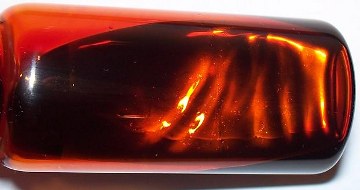
Bromine
Bromine General
| Name:Bromine | Symbol:Br |
| Type: Halogen | Atomic weight:79.904 |
| Density @ 293 K:3.122 g/cm3 | Atomic volume:23.5 cm3/mol |
|
Discovered:
Bromine was discovered by A.J. Balard in 1826 in Montpellier, France. The name comes from the Greek word "bromos" meaning "stench". |
|
Bromine States
| State (s, l, g):liquid | |
| Melting point:277 K (-7 °C) | Boiling point:332 K (58.9 °C) |
Bromine Energies
| Specific heat capacity:0.473 J g-1 K-1 | Heat of atomization:112 kJ mol-1 |
| Heat of fusion:10.57 kJ mol-1 of Br2 | Heat of vaporization :29.96 kJ mol-1 of Br2 |
| 1st ionization energy:1139.9 kJ mol-1 | 2nd ionization energy:2103.4 kJ mol-1 |
| 3rd ionization energy:3473.4 kJ mol-1 | Electron affinity:324.7 kJ mol-1 |
Bromine Oxidation & Electrons
| Shells:2,8,18,7 | Electron configuration: [Ar] 3d10 4s2 4p5 |
| Minimum oxidation number: -1 | Maximum oxidation number:7 |
| Min. common oxidation no.: -1 | Max. common oxidation no.:5 |
| Electronegativity (Pauling Scale):2.96 | Polarizability volume:3.1 Å3 |
Bromine Appearance & Characteristics
| Structure:layers of Br2 | Color:red-brown |
| Hardness:mohs | |
|
Harmful effects:
Bromine is poisonous and causes skin burns. |
|
|
Characteristics:
Pure bromine is diatomic, Br2. Uses: Bromine compounds are used as pesticides, dyestuffs, water purification compounds, and as a flame-retardants in plastics. |
|
Bromine Reactions
| Reaction with air:none | Reaction with 6 M HCl:none, dissolves Br2(aq) |
| Reaction with 15 M HNO3: | Reaction with 6 M NaOH:mild, ⇒ OBr-, Br- |
Bromine Compounds
| Oxide(s):Br2O, BrO2 | Chloride(s): BrCl |
| Hydride(s):HBr |
Bromine Radius
| Atomic radius:115 pm | Ionic radius (1+ ion):pm |
| Ionic radius (2+ ion):pm | Ionic radius (3+ ion):pm |
| Ionic radius (2- ion):pm | Ionic radius (1- ion):182 pm |
Bromine Conductivity
| Thermal conductivity:0.12 W m-1 K-1 | Electrical conductivity:1.0 x 10-10 S m-1 |
Bromine Abundance & Isotopes
| Abundance earth's crust:2.4 parts per million, 0.6 by moles | |
| Abundance solar system:parts per billion by weight, parts per billion by moles | |
| Cost, pure: $5 per 100g | |
| Cost, bulk:$0.15 per 100g | |
|
Source:
Bromine is obtained from natural brine deposits. Some bromine is still extracted today from seawater, which contains only about 70 ppm. |
|
|
Isotopes:
26 whose half-lives are known, with mass numbers 68 to 94. Of these, only two are stable: 79Br and 81Br. |
|
Bromine Other
|
Other:
|
|
Prev: Selenium Next: Krypton |